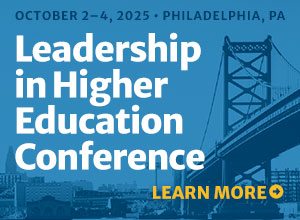Well-Being and Well-Thinking: How to Stay Healthy in Academia
This article first appeared in Academic Leader on March 16, 2020. © Magna Publications. All rights reserved. Resilience is about growing both personally and professionally when we face difficult situations. It is about coming out the other side as a stronger or more prepared person rather than bouncing back to...
Leading Your Academic Department Toward Inclusion: How to Ensure Faculty are LGBTQ+ Competent
During my six years at the University of Connecticut, I had the opportunity to interact with many different faculty members across our campus community. This was particularly true during my final two years, when I coordinated our Rainbow Center’s Out to Lunch (OTL) Lecture Series. The OTL Lecture Series—our center’s...
Creating Dialogue in the Interest of Social Justice on Campus
In a polarized national climate, free speech and First Amendment protections have drawn increasing attention on college campuses. With the advent of open white nationalism, expressions of white supremacy, and the potential for hate speech, campuses have sought to protect student safety and guard against the harassment of minoritized students....
Conversations about Course Ratings: Encouraging Faculty to Make Changes
Talking with faculty about end-of-course ratings is generally a high-stakes conversation where merit raises, promotions, or permanent contracts are on the line or at least hovering in the background of the exchange. Most chairs, program coordinators, or division heads would like to use the conversation for more formative purposes—to engage...
Establishing and Supporting a Faculty Mentoring Program
For many new hires, tenure-track or not, there isn’t a road map for navigating that challenging first year of teaching. A faculty mentor program can help ensure every new hire has a guide, friend, confidante, and role model. The end result of such a program should be a more confident...
Target Mentoring: A Tailored Mentoring Program for Faculty
t the University of Maine, my colleagues and I have conducted a lot of research on faculty mentoring. The campus-wide Rising Tide Center—funded originally by a National Science Foundation ADVANCE grant—has helped implement several kinds of mentoring programs across our campus, finding that a combination of mentoring programs is best...
Petty Principles for Women in Higher Education: Realistic and Practical Advice for Success in Higher Education Leadership
According to recent research, women in higher education continue to consistently be underrepresented at the administrative levels of dean, chief academic officers, provost, and president (Gallant, 2014). There are numerous motives identified by researchers for the persistence of the underrepresentation of women in the top ranks of leadership in higher...
Developing Critical Cross-cultural Communicative Competence in Academic Leaders
According to Chun and Evans (2018), continued white hegemonic practices in university and college administration and faculty have failed to develop a representative institutional culture and organizational structure that is responsive to the needs of diverse students and faculty. The purpose of this article is to discuss this issue, relate...
Rewarding Excellent Support for Non-tenure-track Faculty, Part II
The annual Delphi Award presents a $15,000 cash award to each of two applicants who have worked to support non-tenure-track, contingent and/or adjunct faculty. In the first installment of this article, we examined how California State University, Dominguez Hills, supports its non-tenure-track faculty. We continue with the next institution recognized...
Rewarding Excellent Support for Non-tenure-track Faculty, Part I
For decades, campuses have hired increasing numbers of non-tenure track faculty. The number of adjunct faculty is now more than 52 percent of faculty nationally and full-time non-tenure track make up another 18 percent of the faculty, with all types of non-tenure-track faculty (NTTF) accounting for 70 percent of faculty...












